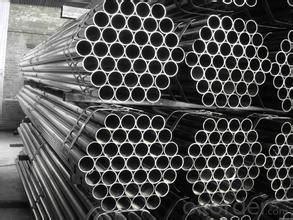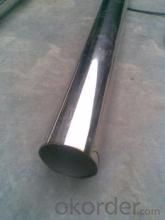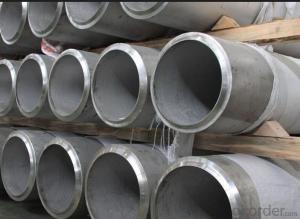Stainless Seamless Round Hot Rolled Pipe
- Loading Port:
- China main port
- Payment Terms:
- TT or LC
- Min Order Qty:
- 100 m.t.
- Supply Capability:
- 10000 m.t./month
OKorder Service Pledge
OKorder Financial Service
You Might Also Like
1、Structure of Seamless Pipe :
Seamless pipe is regarded as withstanding pressure better than other types, and was often more easily available than welded pipe.
2、Main Features of the Seamless Pipe :
• Strong heat dissipation ability
• Good visual effect
• Reasonable price
• High manufacturing accuracy
• High strength
• Small inertia resistance
3、Seamless Pipe Specification:
Standard | GB, DIN, ASTM ASTM A106-2006, ASTM A53-2007 |
Grade | 10#-45#, 16Mn 10#, 20#, 45#, 16Mn |
Thickness | 8 - 33 mm |
Section Shape | Round |
Outer Diameter | 133 - 219 mm |
Place of Origin | Shandong, China (Mainland) |
Secondary Or Not | Non-secondary |
Application | Hydraulic Pipe |
Technique | Cold Drawn |
Certification | API |
Surface Treatment | factory state or painted black |
Special Pipe | API Pipe |
Alloy Or Not | Non-alloy |
Length | 5-12M |
Outer Diameter | 21.3-610mm |
Grade | 20#, 45#, Q345, API J55, API K55, API L80, API N80, API P110, A53B |
Standard | ASME, ASTM |
1) Material:20#(ASTM A 106/A53 GRB.API5LGRB,GB),45#,16Mn,10#.
2) Specification range:OD:21.3-610mm,WT:6-70mm,length:6-12m or according to the requirement of clients.
3) Excutive standards:GB,ASME API5L.ASTM A 106/A53,Despite of the above standards,we can also supply seamless steel pipe with standard of DIN,JIS,and so on,and also develop new products according to the requirements of our clients!
4) Surface:black lacquered,varnish coating or galvanized.
5) Ends:Beveled or square cut,plastic capped,painted.
6) Packing:bundles wrapped with strong steel strip,seaworthy packing.
4、Packaging & Delivery
Packaging Details: | seaworthy package,bundles wrapped with strong steel strip |
Delivery Detail: | 15-30days after received 30%TT |
5、FAQ of Seamless Pipe :
①How is the quality of your products?
Our products are manufactured strictly according to national and internaional standard, and we take a test on every pipe before delivered out. Guaranteed: If products’ quality don’t accord to discription as we give or the promise before you place order, we promise 100% refund.
②How about price?
We are factory and be able to give you lowest price below market one, and we have a policy that “ for saving time and absolutely honest business attitude.Please trust the quotation we would give you, it is professional one.
③Why should you chose us?
Chose happens because of quality, then price, We can give you both.Additionally, we can also offer professional products inquiry, products knowledge train(for agents), smooth goods delivery, exellent customer solution proposals.Our service formula: good quality+good price+good service=customer’s trust
SGS test is available, customer inspection before shipping is welcome, third party inspection is no problem.
Any question, pls feel free to contact us !
6、Seamless Pipe


Images:
- Q:Can stainless steel pipes be used for heat exchangers?
- Yes, stainless steel pipes can be used for heat exchangers. Stainless steel is a popular choice for heat exchangers due to its excellent corrosion resistance, high temperature resistance, and durability. It can withstand high pressure and temperature variations, making it suitable for various heat exchange applications. Stainless steel pipes also have good thermal conductivity, allowing for efficient heat transfer. Additionally, stainless steel is easy to clean and maintain, making it a reliable and long-lasting option for heat exchangers in various industries such as chemical, pharmaceutical, food processing, and HVAC.
- Q:Can stainless steel pipes be etched?
- Stainless steel pipes have the capability to undergo etching, a procedure which involves eliminating a thin layer of metal from the pipe's surface to achieve a desired design or pattern. This is typically accomplished by utilizing an acid or chemical solution that selectively dissolves the exposed metal. However, it is worth mentioning that not all grades of stainless steel are equally suitable for etching. Austenitic stainless steels, specifically 304 and 316, are frequently chosen for etching purposes due to their corrosion resistance and ease of etching. The etching process can also be influenced by various factors, including the composition and thickness of the stainless steel, as well as the chosen method and conditions for etching.
- Q:How are stainless steel pipes different from carbon steel pipes?
- Stainless steel pipes are different from carbon steel pipes in terms of their composition and properties. Stainless steel pipes contain a higher percentage of chromium, which forms a protective layer on the surface, making them resistant to corrosion and rust. On the other hand, carbon steel pipes do not have this protective layer and are susceptible to corrosion. Stainless steel pipes are also more durable and have higher tensile strength compared to carbon steel pipes.
- Q:Are stainless steel pipes suitable for gas distribution systems?
- Yes, stainless steel pipes are suitable for gas distribution systems. Stainless steel is a highly durable and corrosion-resistant material, making it ideal for carrying gases. It can withstand high pressures and temperatures, ensuring the safe and efficient distribution of gas. Additionally, stainless steel pipes have a long lifespan, reducing the need for frequent replacements and minimizing maintenance costs. Overall, stainless steel pipes provide a reliable and secure solution for gas distribution systems.
- Q:Why does the 304 stainless steel pipe leak?
- The corrosion resistance of stainless steel is due to the formation of a very thin, adhesive and semi transparent chromium oxide film on the surface of stainless steel. Once this layer of film is destroyed, the chromium in the steel react with oxygen in the atmosphere to recover the film quickly, and mechanical damage can quickly produce a protective film. However, if the chemical erosion by ions, especially chloride ions, will quickly dissolve and corrosion, the result is that the metal surface needle or point, there is a certain depth of small holes, this corrosion is called pitting.
- Q:How do stainless steel pipes compare to copper nickel pipes?
- Stainless steel pipes and copper nickel pipes are both commonly used in various industries for their unique properties and advantages. While they serve similar purposes, there are some notable differences between the two. Firstly, stainless steel pipes are made of an alloy consisting primarily of iron, with significant amounts of chromium and other elements. They are highly resistant to corrosion, making them suitable for applications where durability and longevity are crucial. Stainless steel pipes are also known for their strength, making them ideal for high-pressure environments. Additionally, stainless steel pipes can withstand extreme temperatures, making them suitable for a wide range of applications. On the other hand, copper nickel pipes are composed of an alloy that combines copper and nickel in varying proportions. These pipes are highly resistant to corrosion, especially in seawater environments, which makes them particularly useful in marine applications. Copper nickel pipes also possess excellent thermal conductivity and are resistant to biofouling, making them suitable for heat exchangers and condensers in various industries. In terms of cost, stainless steel pipes are generally more affordable compared to copper nickel pipes. The price difference can be a significant factor when considering large-scale installations or projects with budget constraints. Moreover, the choice between stainless steel and copper nickel pipes also depends on specific requirements and conditions. For instance, if resistance to corrosion is the primary concern, copper nickel pipes would be the preferred option, especially in marine environments. Conversely, if strength, durability, and versatility are more critical, stainless steel pipes would be a better choice. In conclusion, stainless steel pipes and copper nickel pipes have their respective advantages and applications. Both are excellent materials for various industries, but the decision on which to use ultimately depends on factors such as corrosion resistance, strength, thermal conductivity, and budget considerations.
- Q:Stainless steel tube, also known as why tube?
- The longitudinal section can be divided into equal section tube and variable cross section tubeThe variable section tube has a conical tube, a stepped tube and a periodically cross section pipe, etc.
- Q:Can stainless steel pipes be used for irrigation sprinkler systems?
- Yes, stainless steel pipes can be used for irrigation sprinkler systems. Stainless steel is highly resistant to corrosion and rust, making it a durable choice for outdoor applications like irrigation systems. Additionally, stainless steel pipes have excellent strength and can withstand high-pressure conditions, making them suitable for sprinkler systems.
- Q:Can stainless steel pipes be used for steam systems?
- Stainless steel pipes are indeed suitable for steam systems due to their remarkable resistance to corrosion and high temperatures. This material is renowned for its ability to carry steam without deteriorating or corroding, thus ensuring the efficiency and safety of the steam system. Moreover, stainless steel pipes possess low thermal conductivity, which aids in reducing heat loss during the transportation of steam. Consequently, these pipes are highly favored in diverse industries for their durability, reliability, and long lifespan.
- Q:What is the difference between the stainless steel pipe welded pipe and seamless pipe?
- Strength: the strength of the pipeline in the composition of the alloy and alloy containing the same and the same heat treatment of seamless tube and seamed tube essentially consistent strength. After the tensile test and three-dimensional vibration test, tube tearing almost all occurred in the welding point or away from the heated area where. This is because there is little impurity in the weld and the nitrogen content is slightly higher, so the strength of the welded joint is better than that of other parts. However, the ASME Boiler and Pressure Vessel Association believes that the seamed tube can withstand 85% of the allowable pressure, which is mainly due to improved welding equipment data collection prior to today. The provisions of ASME 100% completely under license by ultrasonic testing pressure tube. Similarly, Europe and Asia also stipulates that can ensure the quality of welding performance by eddy current test tube, the eddy current testing is subject to legal procedures and licensed institutions. Trent's eddy current test was approved by the Swedish power division. ASME believes the current loss is relatively small, high-quality performance based on the seamed tube.
1. Manufacturer Overview |
|
|---|---|
| Location | |
| Year Established | |
| Annual Output Value | |
| Main Markets | |
| Company Certifications | |
2. Manufacturer Certificates |
|
|---|---|
| a) Certification Name | |
| Range | |
| Reference | |
| Validity Period | |
3. Manufacturer Capability |
|
|---|---|
| a)Trade Capacity | |
| Nearest Port | |
| Export Percentage | |
| No.of Employees in Trade Department | |
| Language Spoken: | |
| b)Factory Information | |
| Factory Size: | |
| No. of Production Lines | |
| Contract Manufacturing | |
| Product Price Range | |
Send your message to us
Stainless Seamless Round Hot Rolled Pipe
- Loading Port:
- China main port
- Payment Terms:
- TT or LC
- Min Order Qty:
- 100 m.t.
- Supply Capability:
- 10000 m.t./month
OKorder Service Pledge
OKorder Financial Service
Similar products
New products
Hot products
Related keywords



























